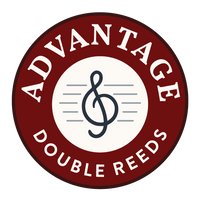
Let's Talk Oboe Reed Staples..
When we discuss oboes reeds, we tend to talk only about the shape used or the gouge. The choice of staples is also an important factor in making reeds that sound and feel good, play in tune and of course, match the bore of the instrument. I’ve played many different instruments and have tried various brands of staples. Thin-wall, thick wall, brass, silver, gold, natural cork, synthetic cork, corkless...I’ve tried them all! Over the course of trying to find that perfect staple, I constantly find myself going back to the 47 mm Advantage French and Artiste staples.
What I love about these Advantage staples is that they are consistent from staple to staple. They’re so affordable. They fit my Loree-style #2 mandrel so there’s no need to find a “special” one for it. The thickness of the walls on these staples are not too thick nor too thin. With my usual Pfeiffer-Mack shape, I can easily tie the reeds at 72 mm. I have also been able to use other traditional shapes on these staples with no issues. The only difference between the French and Artiste is the cork wrapped around them- natural and synthetic respectively. The metal, bore and lengths are all the same.
In my personal findings, the brass staples seem to play a little warmer than the silver. The silver staples play with a little more “zing” or “ring” to the sound. What’s the difference between natural and synthetic cork? The difference is pretty minute. I have found that natural cork dampens the vibrations a little more than synthetic cork, giving it a more “covered” sound. Synthetic cork is less dense than natural cork resulting in a reed that may sound “more free” or “vibrant”. I prefer synthetic over the natural cork simply because they last longer and there is no need for cork grease! Synthetic cork will fit almost any reed well easily.
I use the French and Artiste staples interchangeably in orchestral, chamber and solo settings. I feel that they work really well compared to the “big” Italian, French and German staple makers. The HUGE plus about these staples is that they’re completely made in the USA. Give these staples a try. You’ll be surprised...in a GOOD way!
Dr. Mezraq Ramli,
Malay-American oboist, Mezraq Ramli, enjoys a diverse career as a chamber and orchestral musician, recitalist, teacher and arts administrator. He is the Double Reed Consultant at Advantage Double Reeds, where assists in improvements and development of products in our store. Primarily an oboist, Mezraq is also proficient on the bassoon. Mezraq is Principal Oboe with the South Asian Symphony Orchestra (India), and Second Oboe and English horn with the Baroque on Beaver Music Festival (MI), subbing regularly in the Traverse Symphony Orchestra. He has also performed with several regional orchestras in the US including the Great Lakes Chamber Orchestra, Lubbock Symphony Orchestra, Big Spring Symphony Orchestra, Middletown Symphony Orchestra and Holland Symphony Orchestra. As an educator, Mezraq is Instructor of Oboe at Northwestern Michigan College and also teaches double reeds in the Traverse City Area Public Schools. Previously, he was Oboe Instructor at Saginaw Valley State University and Adjunct Instructor of Double Reeds at Lubbock Christian University. Mezraq received his DMA from Texas Tech University, MM from Miami University and BM from Grand Valley State University. His principal oboe teachers include Amy Anderson, Andrea Ridilla and Marlen Vavrikova. His principal bassoon teachers include Richard Meek and John Clapp.
